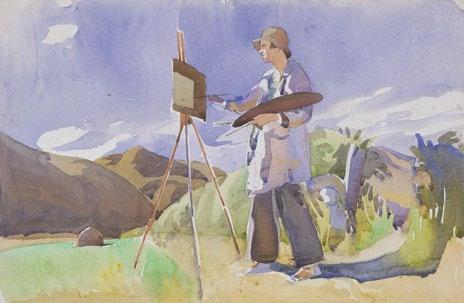
2 minute read
Programme
Olivia Spencer Bower, Ngaio Marsh Painting, c1936.
11 The Robert McDougall Art Gallery was later superseded as the central hub of art by the Christchurch Art Gallery Te Puna o Waiwhetū in 2002, and then decommissioned after substantial earthquake damage in 2010 and 2011. In the later years of the 1950s and 1960s, a time of consistency and consolidation for The Group, shows became the centralised exhibition platform for a new wave of young artists that hosted the display of now extremely significant names from across New Zealand. Notable artists featured frequently in catalogues and exhibitions including Pat Hanly, Don Binney, Tony Fomison, Philip Trusttum, Quentin MacFarlane, Ralph Hotere, and John Drawbridge. Colin McCahon exhibited some of his most iconic works with The Group during the 1960s. In 1962, The Group offered a public subscription to buy McCahon’s Tomorrow will be the same but not as this is (1958-59) for the city of Christchurch. The painting is now held in the Christchurch Art Gallery Te Puna o Waiwhetū collection. Strong annual exhibitions continued into the 1970s, championing notable female artists such as Robin White and Gretchen Albrecht. The Group disbanded in 1977. This came after 50 years of sustained annual exhibitions, except for a brief period when The Group became the New Zealand Society of Artists, and during the Second World War. This disbandment was largely due to a changing cultural context; globalisation was shifting the narrative on New Zealand’s national isolation, and the local art scene had evolved. The public were increasingly engaged with the arts, and dealer art galleries were proliferating. The Group’s 1977 survey exhibition, 50 years after its establishment, was held at Robert McDougall Art Gallery. At this time, the gallery enjoyed the distinction of being Christchurch’s predominant art gallery. The show was a significant full-circle moment. The Group had started as an alternative community and exhibition space for art and artists outside of institutional norms, and it ended with a prestigious show in an established gallery. The survey show was held during Robert McDougall Art Gallery’s heyday as the city’s major gallery; exhibiting the non-conformist contemporary art group bolstered the gallery’s status even further.11 This advantage was mutually beneficial. The gallery’s endorsement of The Group increased its status, highlighting its historical influence and important role in Christchurch city’s vibrant art history. The Group left an enduring legacy as a nexus of intersecting relationships that promoted the production and display of 20th century contemporary art which has resonances within New Zealand culture to this day.




